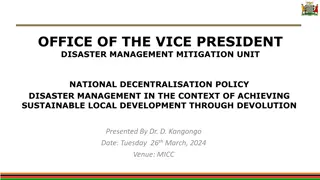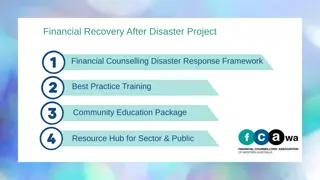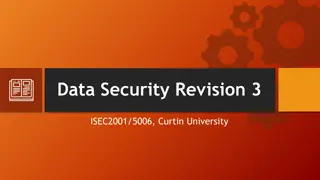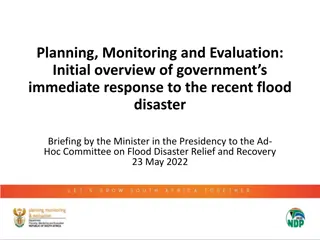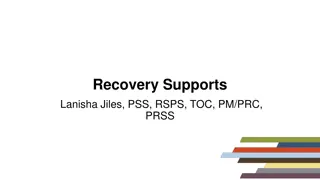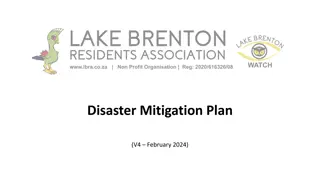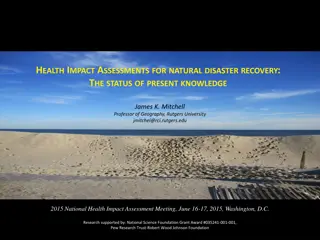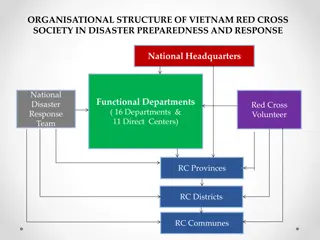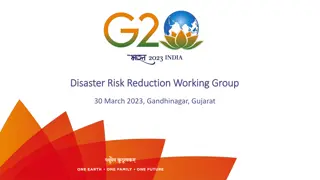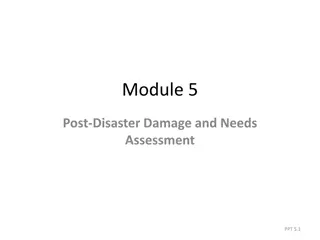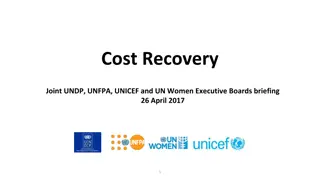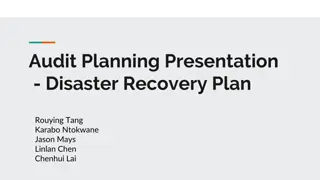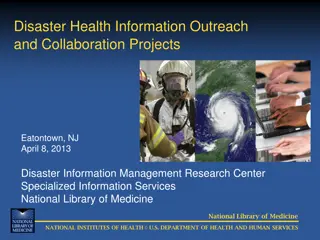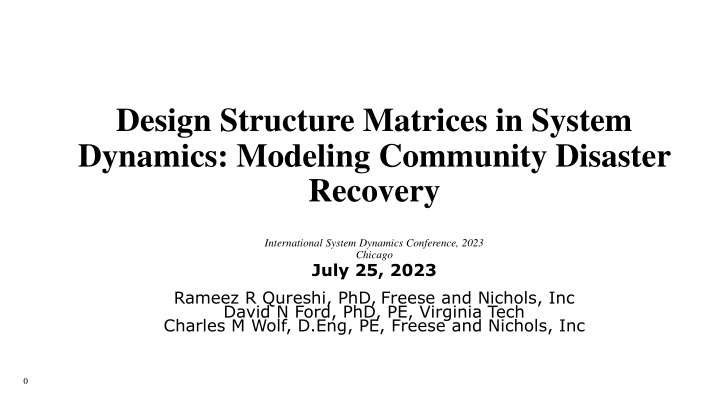
Modeling Community Disaster Recovery Dynamics
This content explores the challenges and strategies in community disaster recovery, focusing on resource allocation, infrastructure interdependencies, and feedback interactions. It discusses the use of Design Structure Matrices and System Dynamics to enhance recovery performance. The feedback theory and simulation models further aid in understanding the recovery process and advancing restoration activities post-disaster.
Uploaded on | 0 Views
Download Presentation

Please find below an Image/Link to download the presentation.
The content on the website is provided AS IS for your information and personal use only. It may not be sold, licensed, or shared on other websites without obtaining consent from the author. If you encounter any issues during the download, it is possible that the publisher has removed the file from their server.
You are allowed to download the files provided on this website for personal or commercial use, subject to the condition that they are used lawfully. All files are the property of their respective owners.
The content on the website is provided AS IS for your information and personal use only. It may not be sold, licensed, or shared on other websites without obtaining consent from the author.
E N D
Presentation Transcript
Design Structure Matrices in System Dynamics: Modeling Community Disaster Recovery International System Dynamics Conference, 2023 Chicago July 25, 2023 Rameez R Qureshi, PhD, Freese and Nichols, Inc David N Ford, PhD, PE, Virginia Tech Charles M Wolf, D.Eng, PE, Freese and Nichols, Inc 0
Community Natural Disaster Recovery Restoration of normal patterns of household, business, and government activities FEMA 2011 Schematic Disaster Recovery (Miles and Chang 2006) Determining optimal resource sequencing, amounts, and timing to improve recovery is challenging Conceptualization Introduction Validation Application Methodology
The Practitioners Problems Widespread damage, limited resources, infrastructure interdependencies, and competing sectoral priorities make resource allocation challenging Invest in public health vs infrastructure? Invest in manufacturing vs agriculture? How should disaster managers allocate limited resources for improved recovery? What recovery resourcing strategies can improve community disaster recovery performance? Conceptualization Introduction Validation Application Methodology
System Dynamics and Design Structure Matrix Supplying Sectors Compact format, visual representation, powerful analytical tools make DSM useful for modeling tightly coupled systems Receiving Sectors DSMs are not useful in modeling delays, feedback, and the impact of decision-making DSM was used in an SD model to simulate the requisite interdependent feedback interactions in community recovery Typical Design Structure Matrix Conceptualization Introduction Validation Application Methodology
Feedback Theory of Community Recovery Restoration activities continue to restore the damaged infrastructure until adequate physical infrastructure is made available to meet the population needs. - Natural Disaster - - *For simplification purposes, CLD shows the interaction only between Housing and Construction sector Conceptualization Introduction Validation Application Methodology
Simulation Model Subsystem Diagram Community recovery efforts are driven by the local demand for infrastructure services Population that can be supported depend on the available infrastructure services Community Recovery System Model Schematics Conceptualization Introduction Validation Application Methodology
System Structure Diagram The damaging and restoration of physical infrastructures are modeled using a three-stock aging chain with a single return flow to simulate the infrastructure damage In the formal model there is a copy of the structure shown below for all the sixteen community sectors Legend of Loops (partial): R1: Restoration Capacity Growth Loop B1: Population Goal Seeking Loop Feedback Structure of Community Infrastructure Restoration Conceptualization Introduction Validation Application Methodology
Integration of DSM and SD Models Capacity of an infrastructure at any time is a function of Dependencies among infrastructure systems (Loop R1) Available workforce (Loop R2) Available physical infrastructure (Loop B1) Legend of Loops: R1: Sector Operations Growth Loop R2: Workforce Growth Loop B1: Population Goal Seeking Loop Feedback Structure of Community Growth Conceptualization Introduction Validation Application Methodology
Model Calibration Example Model Calibration - Initial Infrastructure Capacity Parameter Metric to Measure Capacity Electric power Generation and Transmission Capacity Sector UoM Value Source New Orleans Energy Department United States Bureau of Economic Analysis United States Bureau of Economic Analysis Mwh/Week Electric Power 1250 M$/Week Commercial Economic Output 354 Data Collected for Recovery of Orleans Parish after Hurricane Katrina in 2005 Installed Value of Construction Industry M$/Week Construction 83 Million Gallons/Week Water Supply & Wastewater Treatment Water Production & Treatment Capacity Sewerage & Water Board of New Orleans 250 Million Gallons/Week Garbage Tons/Week Hospital Beds/Week Sewerage & Water Board of New Orleans Example Data Types Drainage Drainage Capacity 29000 Total Waste Collection Capacity Number of Available Hospital Beds Total Functional Lane Mileage Sanitation 3000 City of New Orleans Community Characteristics: Population, Per Capita Demand, Migration Duration Public Health 2269 City of New Orleans Lane Miles/Week Road Transportation 1547 City of New Orleans Other Modes of Transportation Passengers/Week Cargo Capacity 222000 City of New Orleans Thousand Gallons/Week Total Gasoline Sales/Deliveries Total Food Distribution Capacity Number of Functional Hotel Beds United States Energy Information Administration Fuel Distribution 25830 Hazard Characteristics: Type, Duration, Extent of Damage Ksqft/Week Food & Agriculture 320400 City of New Orleans Hotel Beds/Week Tourism 40000 City of New Orleans Customer Base/Week ICT Reachability 400 City of New Orleans Community Sector-Specific Characteristics: Sector Capacity, Time to Issue Permits, Rate of Restoration, Resource Allocation Operating Administrative Budget K$/Week Governance 722 City of New Orleans Student Enrollments/Wee k Ksqft/Week Education Total number of enrollments 172219 City of New Orleans Housing Total Housing Built Area 769095 City of New Orleans Conceptualization Introduction Validation Application Methodology
Model Behavior Assessment In combination with other validation tests, the results support the model s usefulness for simulating community recovery from shock events Community Recovery System Behavior Reproduction Test Based on Orleans Parish Population Data Conceptualization Introduction Validation Application Methodology
Model Use for Policy Design and Testing How should disaster mangers allocate limited resources across community sectors? What criteria-based resource allocation strategy design yields improved recovery performance and why? Recovery Performance Metrics Recovery Duration Time for Population to Recover to 95% of Pre-Disaster Performance Loss Average Lost Capacity in %Pre-Disaster Capacity Conceptualization Introduction Validation Application Methodology
Base Case Simulation Initial Conditions: Time of Disaster @50th week Equal damage to all sectors@50% of initial capacity External Aid of $25billion allocated equally (6.25%) to all sectors Actual Operational Capacity of Sectors Fractional Services/Week 1 0.6 0 70 140 210 280 Time (Week) 350 420 490 560 630 Actual Operational Capacity of Sectors[Electric Power] : Base Case_Equal Allocation Actual Operational Capacity of Sectors[Commercial] : Base Case_Equal Allocation Actual Operational Capacity of Sectors[Construction] : Base Case_Equal Allocation Actual Operational Capacity of Sectors[Water] : Base Case_Equal Allocation Actual Operational Capacity of Sectors[Drainage] : Base Case_Equal Allocation Actual Operational Capacity of Sectors[Sanitation] : Base Case_Equal Allocation Actual Operational Capacity of Sectors[Public Health] : Base Case_Equal Allocation Actual Operational Capacity of Sectors[Road Transportation] : Base Case_Equal Allocation Actual Operational Capacity of Sectors[Other Transportation] : Base Case_Equal Allocation Actual Operational Capacity of Sectors[Fuel Supply and Distribution] : Base Case_Equal Allocation Actual Operational Capacity of Sectors[Food] : Base Case_Equal Allocation Actual Operational Capacity of Sectors[Tourism] : Base Case_Equal Allocation Actual Operational Capacity of Sectors[ICT] : Base Case_Equal Allocation Actual Operational Capacity of Sectors[Governance] : Base Case_Equal Allocation Actual Operational Capacity of Sectors[Education] : Base Case_Equal Allocation Actual Operational Capacity of Sectors[Housing] : Base Case_Equal Allocation Recovery Behavior of Interdependent Community Sectors Numerical Community Recovery DDSM Recovery Performance Metrics Average Lost Performance 14% Recovery Duration441 weeks Conceptualization Introduction Validation Application Methodology
Comparison of Resource Allocation Strategies The result suggests that both restoration speed and sector dependencies are important guides to improved recovery resource allocation Comparison of Recovery Resourcing Strategies Disaster Recovery Resourcing Strategy Performance Summary Recovery Resourcing Policies Comparison 100% %Improvement Over Base Case %Improvement in Recovery Perfornmance wrt Base 77% Recovery Performance 69% Resource Funding Policy Recovery Duration (Weeks) 441 50% Recovery Duration Performanc e Loss Performanc e Loss 14% 31% 14% 10% 9% 6% 6% Base Case P1 Sector Restoration Rate P2 Resilience Improvement P3 World Bank Recovery Framework P4 In-Degree Centrality P5 Out-Degree Centrality 0% 0% 0% P1 P2 Resilience Improvement P3 World Bank Recovery Framework P4 InDegree Centrality P5 OutDegree Centrality 102 4% +77% +69% Case Characteristic Restoration Rate Recovery Time Lost Performance 416 13% +6% +9% -50% 417 12% +6% +14% -100% 305 13% +31% +10% -113% 940 52% -113% -272% -150% Intersectoral Prioritization Criteria for Community Recovery Planning Conceptualization Introduction Validation Application Methodology
Improved Recovery Resourcing Strategy The most important community resourcing features driving recovery are the extent of damage, infrastructure restoration speeds, and infrastructure interdependencies. Recovery Performance Metrics Lost Performance = 53% Improvement over base-case Recovery Duration = 55% Improvement over base-case Conceptualization Introduction Validation Application Methodology
Improved Recovery Resourcing Strategy The most important community resourcing features driving recovery are the extent of damage, infrastructure restoration speeds, and infrastructure interdependencies. The extent of damage can be impacted by mitigation projects Infrastructure restoration speed can be impacted by emergency public policies (e.g. permitting speed) Infrastructure interdependencies can be improved through increased robustness Conceptualization Introduction Validation Application Methodology
Conclusions Contributions to Research Integration of System Dynamics and Design Structure Matrix modeling approach Contributions to Practice Development of a feedback theory of community recovery consisting of many interacting sectors Developed a simulation model that be can be calibrated to communities with specific characteristics for community-specific recovery resourcing strategy Simulated the behavior of complex interdependent community sectors with different rates of restoration Designed a cross-sector resource allocation prioritization criteria for a faster community recovery with reduced loss in functionality Tested and compared impacts of resourcing heuristics on community recovery duration and lost performance Conceptualization Introduction Validation Application Methodology
THANK YOU! It s your reaction to adversity, not adversity itself that determines how your life s story will develop. - Dieter F. Uchtdorf



